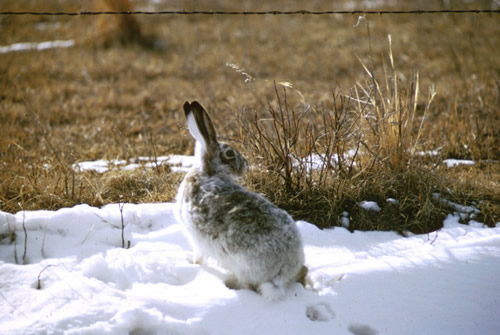
A white-tail jackrabbit turning white during early winter
Winter’s white jackrabbit
By Larry Hyslop

A white-tail jackrabbit turning white during early winter
This winter of little snow has been tough on smaller mammals that use snow as an insulating cover. Worse, however, is the case of the white-tailed jackrabbit. Their fur turns white in response to fall’s shortening days, not to actual snow covering the ground. For most of this winter, white-tailed jackrabbits have been highly visible in their brown landscape. Only with a thin snow cover does their coloration help in concealment.
Although people commonly call this rabbit a snow-shoe rabbit or hare, the true snowshoe hare is only found in the Sierra Nevada. The white-tailed jackrabbit is Elko County’s only hare that turns white for winter.
The other area jackrabbit is the larger black-tailed jackrabbit. Besides its dark tail, this hare is darker overall. The white-tailed jackrabbit has a white tail and even during summer is a lighter color.
The black-tailed jackrabbit is common throughout Elko County and Nevada, occasionally even entering my yard for a late night snack. The white-tailed jackrabbit is common only in northern Elko County, around Wild Horse and Mountain City, although also in northern Ruby Valley. The closest sighting to Elko I have heard is just north of Adobe Summit. White-tailed jackrabbits are more accustomed to grasslands, farmlands and mountainous terrain than the desert sagebrush habitat of black-tails. Our recent large wildfires have converted a lot of sagebrush-covered land to grassland and may be helping the population of white-tailed jackrabbits.
Ken Gray is the Head Game Biologist for the Nevada Department of Wildlife here in Elko. He described to me NDOW’s different management for these two hare species. The black-tail is an unprotected animal, meaning they can be hunted at any time and with no bag limit. The white-tail, however, is a game animal and can only be hunted during its hunting season. Not many hunters chase white-tails other than during winter to obtain the white pelt. He feels the white-tail population does not cycle as much as the black-tail, remaining more level over the years.
A Shoshone elder described to me their view of the two types of jackrabbit. The black-tail has always been prized as both food and a source of fur for rabbit fur blankets. The meat of the white-tail is considered stringy and poor. It is not generally hunted.
As hares, neither type of jackrabbit digs burrows. Their only protection is a “scrape”, a protected spot at the base of a sagebrush scraped clean of debris. Jackrabbit babies, called leverets, are born in these scrapes, the leverets covered in fur and with eyes open. Not being born in a protected burrow, they are soon ready to run from danger.
I have seen a black-tail explode from the snow barely in front of my skis and found a tunnel as long as my arm. This spot was probably its scrape before being buried under snow. The jackrabbit may have first tunneled upward to escape the snow cover and then used the tunnel to return to its scrape, a much warmer microclimate than on top of the snow.
Elko Daily Free Press, “Nature Notes”, 2/2/2012
© Gray Jay Press, Elko, NV
Return to Elko Nature Notes